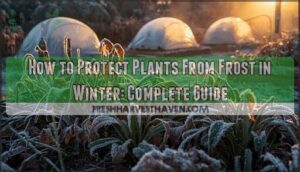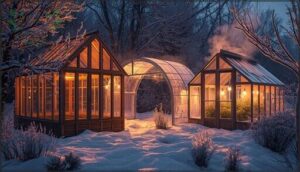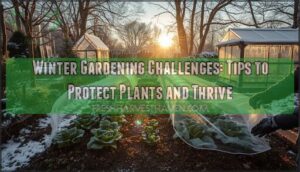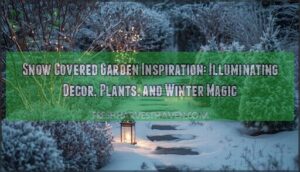This site is supported by our readers. We may earn a commission, at no cost to you, if you purchase through links.
A single overnight freeze can destroy months of careful gardening work, turning vibrant foliage into blackened mush by sunrise. Frost doesn’t just make leaves look crispy—it ruptures cell walls from the inside out, draining moisture and cutting off nutrient flow until entire plants collapse.
The difference between a light freeze at 30°F and a hard frost at 28°F determines whether your tomatoes suffer minor leaf damage or die completely, yet most gardeners don’t realize how much control they actually have over these outcomes.
Learning how to protect plants from frost in winter means understanding when cold strikes hardest, which varieties need immediate shelter, and which proven methods—from simple bed sheets to strategic watering—keep roots warm and tissues intact through unpredictable temperature swings.
Table Of Contents
- Key Takeaways
- Why Frost Damages Plants in Winter
- Which Plants Need Frost Protection Most
- When and How to Identify Frost Risk
- Best Methods to Protect Plants From Frost
- Extra Tips for Successful Winter Plant Protection
- Frequently Asked Questions (FAQs)
- What is the best material to cover plants from frost?
- What not to cover plants with for frost?
- Will plastic garbage bags protect plants from frost?
- Should I cover my plants at 32 degrees?
- At what temperature should you cover your plants at night?
- How do I prevent frost in my garden?
- Should you put frost protection in Your Winter Garden?
- How to protect plants from a frosty chill?
- How to protect plants from frost?
- When do you need frost protection for plants?
- Conclusion
Key Takeaways
- A hard frost at 28°F or below kills most annuals outright, while a light freeze between 29°F and 32°F damages only tender plants—knowing this difference helps you decide which plants need immediate protection.
- Covering plants with breathable materials like frost cloth or old sheets traps ground heat and can raise temperatures beneath the cover by 2–8°F, giving frost-sensitive plants the shield they need to survive cold snaps.
- Watering your soil deeply 24 to 48 hours before a predicted frost lets moist ground hold up to four times more heat than dry soil, providing natural insulation that protects roots through the night.
- Low spots in your garden can become frost pockets up to 4°C colder than higher ground, so identifying these areas through careful observation lets you target your protection efforts where they matter most.
Why Frost Damages Plants in Winter
Frost isn’t just cold air settling on your garden—it’s a real threat that can wreak havoc on plant tissues overnight. Understanding how frost forms and what it does to your plants is the first step in protecting them effectively.
Let’s break down the science behind frost damage, the different types you’ll encounter, and how to spot trouble before it’s too late.
How Frost Forms and Affects Plants
Frost formation happens when water vapor in the air skips becoming liquid and deposits directly as ice crystals on plant surfaces—especially on clear, calm nights when heat radiates away quickly. This process causes three main problems for your frost-sensitive plants:
- Ice crystals rupture cell walls, tearing delicate tissues apart
- Water gets pulled out of cells, leading to dehydration and wilting
- Cellular damage disrupts nutrient flow, weakening overall plant health
Understanding frost formation helps you time your frost protection strategies effectively throughout the winter frost season. To mitigate damage, it’s vital to understand frost damage symptoms and take preventive measures.
Types of Frost (Light Vs. Hard)
Not all cold snaps hit your garden the same way. Understanding the differences between light freezes and hard frosts helps you decide which plants need protection when winter frost threatens. A light freeze, occurring between 29°F and 32°F, damages frost-sensitive plants like tomatoes but leaves hardy perennials unharmed. Hard frost, at 28°F or below, kills most annuals outright and damages woody plant tissues. To better prepare for such events, it’s vital to study the fall frost dates in your area.
| Frost Type | Temperature Range | Plant Impact |
|---|---|---|
| Light Freeze | 29°F–32°F | Kills tender annuals; hardy plants survive |
| Hard Frost | 28°F or below | Destroys most annuals and non-hardy vegetation |
Signs of Frost Damage in Plants
Once the freeze hits, you’ll notice the damage fast. Wilted leaves often show up within hours, followed by brown or black patches on frost-sensitive plants within days.
Stem damage like splitting or dark streaks signals serious injury, while water-soaked, translucent tissue means cells have ruptured.
Recognizing these frost symptoms early helps you assess which plants need immediate protection and which can bounce back naturally.
Which Plants Need Frost Protection Most
Not every plant in your garden needs the same level of protection when temperatures drop. Some can handle a nip in the air just fine, while others won’t survive even a light frost.
Let’s look at which plants you should focus on protecting so you can prioritize your efforts and keep your most vulnerable plants safe.
Tender Annuals and Perennials
When temperatures hover near freezing, your tender annuals like impatiens and zinnias face serious frost damage—they can’t handle anything below 36°F. These frost-sensitive plants lack the cold acclimation of hardier varieties, making plant protection essential.
Without proper winterization techniques and frost tolerance measures, you’ll see wilting within 24 hours, and tissue damage can wipe out your entire garden overnight.
Tropical and Warm-Weather Plants
Your hibiscus, citrus trees, and other tropical plants show cold stress below 50°F—well before actual frost damage hits. Without cold hardiness or plant acclimation, these frost-sensitive plants suffer cellular breakdown, wilting, and browning when temperatures dip near freezing.
Tropical care means providing winter protection early, because even brief cold weather exposure causes irreversible tissue injury in species lacking frost tolerance.
Young Seedlings and Potted Plants
Seedling care demands serious winter gardening attention—your youngest plants face mortality rates up to 75% after early spring frost. These tender plants lack the frost resilience of mature specimens, showing cold tolerance 4°F lower than adults.
Potted plant tips matter too, since containers expose roots to freezing faster than ground soil.
Proper plant insulation with mulch and coverings becomes critical plant protection, preventing frost damage that stunts or kills frost-sensitive plants outright.
Cold-Tolerant Vs. Sensitive Varieties
Genetic adaptations separate survivors from casualties: cold-hardy perennials bred from northern latitudes tolerate temperatures 10–15°F lower than frost-sensitive plants from warmer origins. Your USDA zone rating reveals which varieties possess true cold tolerance.
Hardy roses and northern grasses display frost tolerance genes that activate below 0°F, while tender plants like tropical hibiscus lack winter survival mechanisms entirely, making plant hardiness critical for protection decisions.
When and How to Identify Frost Risk
Knowing when frost is likely to strike gives you the upper hand in protecting your plants before damage occurs. You can’t rely on guesswork alone—timing and location matter just as much as temperature.
Let’s walk through the key tools and strategies that help you stay one step ahead of frosty nights.
Understanding Local Frost Dates
Your garden’s frost timeline isn’t guesswork—frost date calculators pinpoint your area’s spring and fall freeze schedule using local weather patterns and climate modeling. Check resources like the Old Farmer’s Almanac or extension services for frost risk assessment customized to your ZIP code.
Regional variations matter: neighboring counties can differ by weeks, so tracking your specific frost dates transforms winter gardening tips from generic advice into targeted plant hardiness strategies for effective cold weather gardening and frost protection.
Using USDA Hardiness Zones
Your zone number—ranging from 1a’s brutal −60°F to balmy 13b—unlocks frost tolerance insights essential for regional planting success. USDA Hardiness Zones map your area’s coldest winter extremes, revealing which plants survive local conditions and guiding your frost protection methods.
Climate shifts nudge zone boundaries northward, so checking updated zone mapping and hardiness ratings ensures your cold weather gardening strategies match today’s reality, not outdated assumptions.
Recognizing Frost-Prone Areas in Your Garden
Not all corners of your yard freeze equally—low spots where cold air pools can be 4°C colder than higher ground, turning into frost pockets that triple damage rates.
Low spots in your garden can become frost pockets up to 4°C colder than higher ground, tripling your damage risk
Study your topography to identify these frost-prone areas: depressions, shaded zones behind hedges, and poorly drained sections show the highest frost damage prevention needs through microclimate analysis and strategic plant protection for frost-sensitive plants.
Monitoring Weather Patterns and Alerts
Beyond mapping your garden’s cold spots, you need reliable frost forecasting to time your weather protection correctly. Temperature monitoring through weather alerts gives you advance notice when climate trends signal a dangerous temperature drop.
Check these frost warnings regularly:
- Local weather forecast apps that send push notifications when frost dates approach
- NOAA frost advisories for regional temperature monitoring and climate data
- Garden-specific thermometers placed in your most vulnerable planting zones
Set up alerts now so you’re never caught off guard.
Best Methods to Protect Plants From Frost
When frost threatens your garden, you have several reliable ways to protect your plants and keep them healthy through the cold months. Each method works differently depending on your plants’ needs, your garden setup, and how much time you can invest.
Let’s look at the most effective strategies you can use to shield your plants from freezing temperatures.
Covering Plants With Sheets, Blankets, or Frost Cloth
One of the easiest ways to shield frost-sensitive plants is draping them with breathable covers like frost cloth, old sheets, or blankets. These fabric materials trap radiant ground heat, boosting air temperatures by 2–8°F beneath the cover and providing essential plant insulation and protection.
Frost cloth is especially durable and allows light through, making it a reliable choice for cold protection methods during chilly nights.
Using Mulch for Soil Insulation
Mulch application offers natural soil insulation by locking heat around roots and preventing frost penetration. A 2–4 inch layer of organic materials like straw, shredded leaves, or bark can raise soil temps by up to 8°F while reducing frost heave by 40–60%.
You’ll want to:
- Apply mulch after the first hard frost but before ground freezes
- Keep it 1 inch away from stems to prevent rot
- Spread evenly without compacting for best plant insulation
Building Cold Frames, Hoop Tunnels, and Mini-Greenhouses
For more permanent frost protection, cold frames and hoop tunnels offer season extension that can add 6–8 weeks to your growing time. Mini-greenhouses maintain 50°F inside when it’s -18°F outdoors, while hoop tunnels built with PVC pipe and polyethylene film create microclimates several degrees warmer than ambient air.
These structures let you start planting five weeks earlier in spring and harvest well past fall’s first frost.
Relocating Potted and Tender Plants Indoors
When nighttime temperatures consistently dip below 50°F, bring your frost-sensitive plants indoors to safeguard them from damage.
Place tender plant care specimens in rooms with adequate indoor lighting—8 to 10 hours daily—and maintain indoor humidity between 40% and 60%.
Plant acclimation matters: shelter them in a garage for 3–5 days first, then shift fully inside for complete winter care and frost protection.
Watering Techniques to Retain Ground Heat
Before a predicted frost, water your soil deeply 24 to 48 hours in advance—moist ground holds up to four times more heat than dry soil, giving your plants vital ground insulation and frost prevention.
- Water early in the day to optimize soil moisture absorption and heat retention overnight
- Target the root zone directly, avoiding foliage to prevent additional freeze stress
- Apply 1–2 gallons per plant for effective soil warming and plant protection
- Combine watering with mulch layers to lock in warmth and boost frost prevention
- Monitor soil moisture regularly; avoid overwatering, which can damage roots and reduce water timing benefits
Extra Tips for Successful Winter Plant Protection
Once you’ve got the basics down—covering, mulching, and moving plants—there are a few extra tricks that can make the difference between survival and thriving.
These strategies help you fine-tune your frost protection, whether you’re dealing with surprise cold snaps or seasonal transitions.
Here’s what else you can do to keep your plants safe and healthy through the frosty months.
Using Supplemental Heat Sources (e.g., Incandescent Lights)
When cold weather threatens your frost-sensitive plants, supplemental heating can make all the difference. Old-fashioned incandescent lighting strings generate enough warmth for effective plant protection—unlike LEDs, which stay cool.
Wrap them around cold frames or small trees, then layer frost cloth or blankets over the top for thermal insulation and heat retention. This simple combo keeps frost prevention working through those bitter nights.
Properly Securing and Removing Covers
After cover installation, fasten frost cloth materials firmly to the ground with rocks or garden staples—loose edges let cold air sneak underneath, defeating your plant insulation and protection. Secure fastening is vital for protecting plants from frost effectively.
Remove plant covers promptly when temperatures climb above 32°F, since trapped heat can stress frost-sensitive plants. Ventilation techniques like lifting edges help prevent overheating during sunny spells.
Morning Care After Unexpected Frost
If unexpected frost catches you off guard, quick morning action limits plant damage and helps frost-sensitive plants bounce back. Follow these frost damage assessment and morning thaw procedures for effective plant recovery strategies:
- Wait for gradual warming before removing covers—rapid thawing can cause additional cell wall damage to frost-affected foliage.
- Water at the soil line with 1 inch of lukewarm water once temperatures rise above freezing to rehydrate plant tissues and support plant insulation and protection.
- Apply 2–3 inches of organic mulch for post-frost mulching after soil thaws, stabilizing temperature and aiding winter soil management around your recovering plants.
Preparing Plants for Late Spring and Early Fall Frosts
Late spring and early fall frosts sneak up on frost-sensitive plants when you’re least prepared—sometimes causing up to 75% seedling loss if you skip plant hardening.
Start acclimating tender varieties two weeks early by exposing them gradually to cooler outdoor conditions, monitor soil temperature closely, and select frost-resistant varieties suited to your microclimate management strategy for reliable cold weather protection and seasonal gardening success.
Frequently Asked Questions (FAQs)
What is the best material to cover plants from frost?
Think of your frost cover as a shield—burlap and spun polypropylene frost blankets offer breathability plus insulation, while row covers add 2–6°F protection without trapping harmful moisture that damages cold-weather plants.
What not to cover plants with for frost?
Avoid plastic sheets, non-breathable vinyl covers, black tarps, and synthetic fabrics—these trap moisture, block airflow, and can scorch foliage.
Instead, choose breathable materials for effective freeze protection and cold weather plant damage prevention.
Will plastic garbage bags protect plants from frost?
Plastic garbage bags provide poor plant protection from frost because they lack breathability, trap damaging moisture, and conduct cold when touching foliage.
Use breathable frost cloth alternatives instead for proper freeze protection and insulation.
Should I cover my plants at 32 degrees?
Yes, you should cover your plants at 32°F. This frost threshold marks when tender plants face freeze protection risks, so proper plant insulation and winter protection methods become essential for preventing cold weather damage.
At what temperature should you cover your plants at night?
While hardy perennials tolerate 30°F without worry, you should cover tender plants when nighttime temperature alerts predict lows below 40°F.
This provides essential winter insulation against frost threshold damage through proven covering methods.
How do I prevent frost in my garden?
You can’t stop frost from forming, but you can shield your frost-sensitive plants with covers, mulch for garden insulation, and proper winter care to maintain soil temperature and prevent cold weather damage.
Should you put frost protection in Your Winter Garden?
You absolutely should protect frost-sensitive plants in your winter gardening routine.
Plant insulation and protection methods prevent 80-90% of cold weather damage, safeguarding tender varieties from freeze injury with simple cold protection strategies.
How to protect plants from a frosty chill?
Use frost cloth, mulch, or row covers to shield frost-sensitive plants from cold weather. Relocate pots indoors and water soil before sunset to boost plant insulation and protection against freezing temperatures.
How to protect plants from frost?
Think of your garden as a fortress needing winter armor.
Cover frost-sensitive plants with sheets or frost cloth, apply thick mulch for plant insulation, and relocate tender potted specimens indoors—proven cold protection strategies for frost resilience.
When do you need frost protection for plants?
You need plant protection when temperatures drop below 36°F, especially for frost-sensitive plants during cold weather.
Monitor frost warning alerts and local frost dates, as cold snaps near these temperature thresholds require immediate protective action.
Conclusion
Think of frost protection like building a shield—you can’t stop winter from arriving, but you can decide what gets through. Knowing how to protect plants from frost in winter transforms uncertainty into action, giving you the skills to cover vulnerable crops before temperatures plummet, insulate roots with mulch, and recognize when a hard freeze demands immediate intervention.
Your garden’s survival doesn’t depend on luck; it depends on preparation and timing you control.
- https://www.facebook.com/groups/1826641834295243/posts/3637836256509116/
- https://extension.msstate.edu/publications/protecting-plants-cold-temperatures
- https://pmc.ncbi.nlm.nih.gov/articles/PMC6977023/
- https://www.fao.org/4/y7223e/y7223e08.htm
- https://nwdistrict.ifas.ufl.edu/hort/2021/12/10/protect-your-winter-garden-and-landscape-plants-with-frost-cloth/












